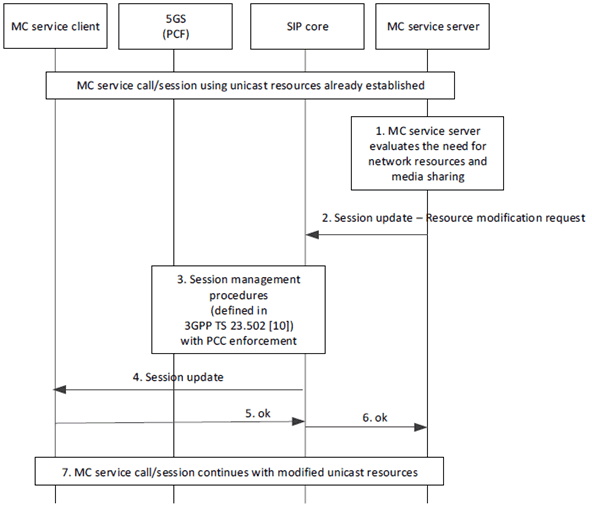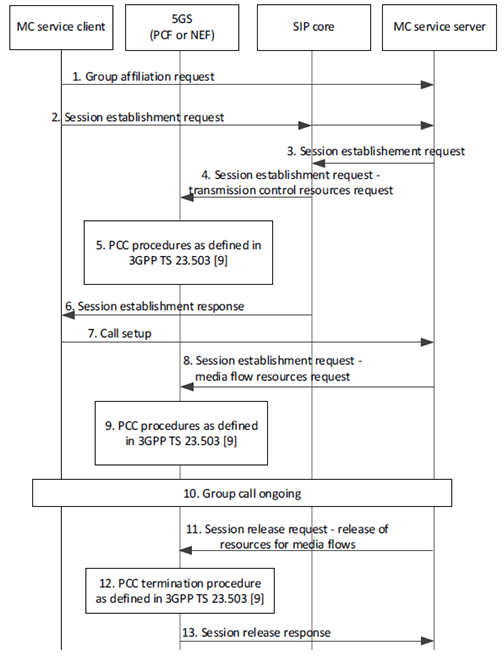Content for TS 23.289 Word version: 19.3.0
0…
4…
4.7…
4.7.4…
4.8…
5…
5.4…
6…
6.3…
6.3.2…
7…
7.2.4…
7.3…
7.3.3…
7.3.3.2…
7.3.3.4…
7.3.3.5…
7.3.3.7…
7.3.3.8…
7.3.3.9…
7.3.3.10…
7.3.3.11…
7.3.3.12…
7.3.3.13…
7.4…
7.5…
7.6…
A…
7.2.4 Request for modification of unicast resources
7.2.5 Request for media resources from MC service server
...
...
7.2.4 Request for modification of unicast resources p. 49
To modify a unicast media flow, the MC service server shall send a resource modification request containing the parameters to be modified, using the call control protocol via the SIP core to the UE. The exchange of the QoS characteristics of the concerned resources takes place exclusively by means of direct interaction between SIP core and PCF.
Possible scenarios when this procedure may be used are:
- Modify the allocation and retention priority for unicast resources;
- Release and resume resources in-between MC service calls when using the chat model; or
- Releasing resources for the media plane should give the option to allow the SIP session to either be torn down or continue.
- An MC service session is already in progress;

Step 1.
MC service server decides to modify the parameters of a unicast bearer (e.g. a request to upgrade the existing MC service call to an MC service emergency or imminent peril call).
Step 2.
MC service server sends a session update which includes a resource modification request containing the modified parameters of the unicast bearer.
Step 3.
Session management procedures using PCF policy control enforcement (as defined in TS 23.503) initiated by the MC service server using direct interaction between SIP core and PCF.
Step 4.
The SIP core local inbound / outbound proxy forwards the session update request to the MC service client.
Step 5.
The MC service client acknowledges the call control protocol request with an OK message.
Step 6.
The SIP core local inbound / outbound proxy forwards the OK message to the MC service server.
Step 7.
The MC service session continues with the modified unicast resources.
7.2.5 Request for media resources from MC service server p. 50
7.2.5.1 General p. 50
The procedure in this sub clause specifies how to request resources for floor control (or transmission control in MCVideo and MCData) and for the media plane can be handled independently. This procedure utilizes the N5 reference point or Rx reference point for direct interaction between MC service server and 5GS (PCF) and for direct interaction between SIP core and 5GS (PCF). Alternatively, resource requests for the media plane can be exchanged indirectly using N33 reference point between MC service server and NEF.
Resources for transmission control are requested at session establishment, in this case the IMS standard procedures using for direct interaction N5 reference point or Rx reference point as specified in TS 23.228 are used. The session description in this procedure shall encompass bandwidth information applicable for the transmission control traffic requirement. At group call setup the request for resources for the media plane is triggered. Either this request is sent directly from the MC service server to 5GS (PCF) or indirectly from the MC service server to 5GS (NEF).
The procedure is optional and is suitable when the procedures for pre-established sessions are used. It may also be used to setup and tear down the media plane used between consecutive group calls in one communication session using the chat call model.
7.2.5.2 Procedure p. 50
The Figure 7.2.5.2-1 illustrates the procedure for resource allocation.

Step 1.
The MC service client sends a request for group affiliation.
Step 2.
The MC service client sends a request to the MC service server for establishment of a communication session.
Step 3.
The MC service server answer the session establishment request and adjust the bandwidth information in the session description. The requested bandwidth shall be minimized to cover the bandwidth requirements for floor control signalling (or transmission control for MCVideo or MCData).
Step 4.
The SIP core request resources towards the 5GS according to the session establishment request.
Step 5.
Session management procedures using PCF policy control enforcement (as defined in TS 23.503) initiated by the SIP Core.
Step 6.
The session establishment request is completed, and a response is sent towards the MC service client.
Step 7.
The MC service client sends a call setup message according to existing procedures.
Step 8.
The MC service server sends a session establishment request for resources for the media plane to 5GS, and the media plane is by that established. For direct interaction, the resource allocation request is exchanged between MC service server and 5GS PCF using N5 reference point or Rx reference point. For indirect interaction, the resource allocation request is exchanged between MC service server and 5GS NEF using N33 reference point. The respective procedures are defined in TS 23.503). This request includes media description relevant for the media plane.
Step 9.
Session management procedures using PCF policy control enforcement (as defined in TS 23.503) initiated by the MC service server either directly via PCF or indirectly via NEF.
Step 10.
Group call is ongoing on the group communication session.
Step 11.
The MC service serve sends a release of media resources to 5GS, and the media plane is by that terminated.
Step 12.
The PCF performs session termination procedure according to TS 23.503.
Step 13.
The PCF sends a session release response back to the MC service server.